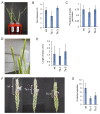Unanticipated Large-Scale Deletion in Fusarium graminearum Genome Using CRISPR/Cas9 and Its Impact on Growth and Virulence
- PMID: 37367609
- PMCID: PMC10303880
- DOI: 10.3390/jof9060673
Unanticipated Large-Scale Deletion in Fusarium graminearum Genome Using CRISPR/Cas9 and Its Impact on Growth and Virulence
Abstract
Fusarium graminearum, a filamentous fungus, and causal agent of Fusarium head blight (FHB) in wheat and other cereals, leads to significant economic losses globally. This study aimed to investigate the roles of specific genes in F. graminearum virulence using CRISPR/Cas9-mediated gene deletions. Illumina sequencing was used to characterize the genomic changes due to editing. Unexpectedly, a large-scale deletion of 525,223 base pairs on chromosome 2, comprising over 222 genes, occurred in two isolates. Many of the deleted genes were predicted to be involved in essential molecular functions, such as oxidoreductase activity, transmembrane transporter activity, hydrolase activity, as well as biological processes, such as carbohydrate metabolism and transmembrane transport. Despite the substantial loss of genetic material, the mutant isolate exhibited normal growth rates and virulence on wheat under most conditions. However, growth rates were significantly reduced under high temperatures and on some media. Additionally, wheat inoculation assays using clip dipping, seed inoculation, and head point inoculation methods were performed. No significant differences in virulence were observed, suggesting that these genes were not involved in infection or alternative compensatory pathways, and allow the fungi to maintain pathogenicity despite the extensive genomic deletion.
Keywords: CRISPR/Cas9 editing; Fusarium graminearum; dual ribozyme sgRNA processing; large deletion.
Conflict of interest statement
The authors declare no conflict of interest.
Figures







Similar articles
-
CRISPR-Cas9 Gene Editing and Secondary Metabolite Screening Confirm Fusarium graminearum C16 Biosynthetic Gene Cluster Products as Decalin-Containing Diterpenoid Pyrones.J Fungi (Basel). 2023 Jun 23;9(7):695. doi: 10.3390/jof9070695. J Fungi (Basel). 2023. PMID: 37504684 Free PMC article.
-
Genome editing using preassembled CRISPR-Cas9 ribonucleoprotein complexes in Fusarium graminearum.PLoS One. 2022 Jun 3;17(6):e0268855. doi: 10.1371/journal.pone.0268855. eCollection 2022. PLoS One. 2022. PMID: 35657788 Free PMC article.
-
The Dynamin-Like GTPase FgSey1 Plays a Critical Role in Fungal Development and Virulence in Fusarium graminearum.Appl Environ Microbiol. 2020 May 19;86(11):e02720-19. doi: 10.1128/AEM.02720-19. Print 2020 May 19. Appl Environ Microbiol. 2020. PMID: 32220839 Free PMC article.
-
Recent advances in genes involved in secondary metabolite synthesis, hyphal development, energy metabolism and pathogenicity in Fusarium graminearum (teleomorph Gibberella zeae).Biotechnol Adv. 2014 Mar-Apr;32(2):390-402. doi: 10.1016/j.biotechadv.2013.12.007. Epub 2014 Jan 2. Biotechnol Adv. 2014. PMID: 24389085 Review.
-
Transcriptomics of cereal-Fusarium graminearum interactions: what we have learned so far.Mol Plant Pathol. 2018 Mar;19(3):764-778. doi: 10.1111/mpp.12561. Epub 2017 Jun 7. Mol Plant Pathol. 2018. PMID: 28411402 Free PMC article. Review.
Cited by
-
NHEJ and HDR can occur simultaneously during gene integration into the genome of Aspergillus niger.Fungal Biol Biotechnol. 2024 Aug 5;11(1):10. doi: 10.1186/s40694-024-00180-7. Fungal Biol Biotechnol. 2024. PMID: 39103967 Free PMC article.
References
-
- Chongo G., Gossen B., Kutcher H., Gilbert J., Turkington T., Fernandez M., McLaren D. Reaction of seedling roots of 14 crop species to Fusarium graminearum from wheat heads. Can. J. Plant Pathol. 2001;23:132–137. doi: 10.1080/07060660109506920. - DOI
-
- Atkins A., Chung C.-H., Allen A.G., Dampier W., Gurrola T.E., Sariyer I.K., Nonnemacher M.R., Wigdahl B. Off-target analysis in gene editing and applications for clinical translation of CRISPR/Cas9 in HIV-1 therapy. Front. Genome Ed. 2021;3:673022. doi: 10.3389/fgeed.2021.673022. - DOI - PMC - PubMed
Grants and funding
LinkOut - more resources
Full Text Sources
Research Materials

